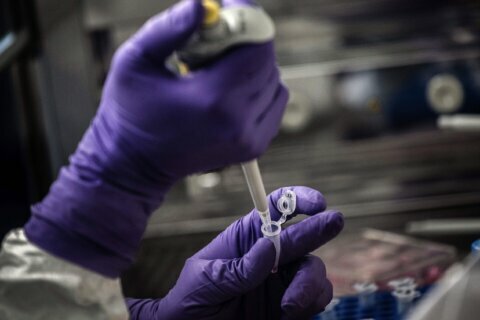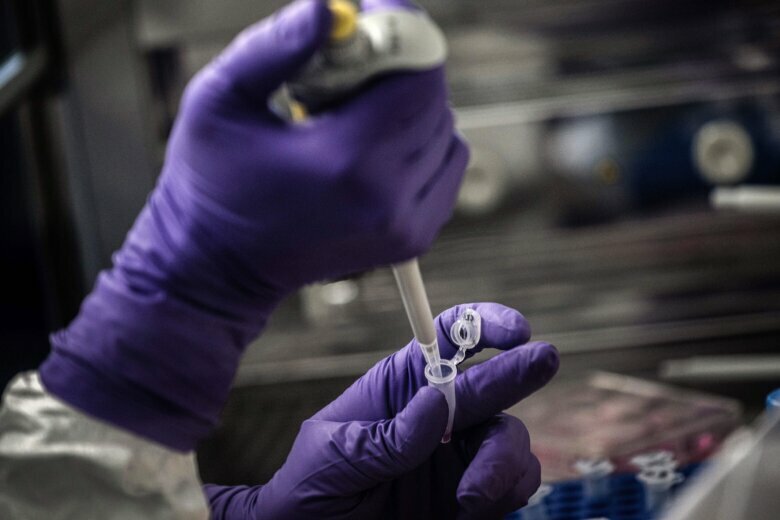
Dr. Myron Cohen began his career fighting HIV in the early 1980s, and he’s been battling the epidemic around the world ever since. But he has never worked as hard to generate new therapies and save lives as he has during the Covid-19 crisis.
“Desperation or urgency can push us away from the scientific method,” said Cohen, now a distinguished professor of medicine, microbiology, and epidemiology at the University of North Carolina School of Medicine. “It is better to not throw stuff against the wall.”
But that’s just what happened during the pandemic, as doctors desperate to save patients any way they could as they filled hospital beds, intensive care units and emergency rooms.
Cohen and other experts say it’s time to return to what works.
Cohen needed to trade on all of his experience after he was called to help lead the Covid-19 Prevention Trials Network, part of the Operation Warp Speed initiative during the Trump administration, and which has continued under the Biden administration’s Covid-19 response team but without the same name.
In the role, he directed studies of Covid-19 monoclonal antibodies, building off existing clinical trial networks for HIV/AIDS. Over the past few decades, the FDA had approved monoclonal antibody therapies for conditions including cancers and autoimmune diseases, as well as HIV in 2018.
The treatment—which he helped pioneer in HIV—involves finding or engineering the most effective antibodies to fight a specific pathogen and infusing them into patients.
If given early in the disease course, monoclonal antibodies can dramatically reduce hospitalizations and save lives.
“All our investments in HIV all paid off with everything we did in Covid,” Cohen said. “To my knowledge, the only drugs that have blunted the progression of disease are monoclonal antibodies.”
Even some of those have failed, however, as the virus evolves into forms that can evade the effects of highly focused antibodies. Scientists agree treatments that specifically attack the coronavirus — antivirals — are vital. To that end, the health and Human Services Department announced a $3.2 billion plan last month to accelerate development of antivirals.
Doctors who specialize in testing new drugs hope the US scientific establishment will do better this time.
Conduct bigger trials coordinated across institutions
In normal times when science isn’t racing against the clock to defeat a pandemic, the process to introduce a new therapy into health care typically begins with first testing drugs in animals, then in humans, and then in clinical trials. This process can take a decade—and often much longer.
When a drug does perform well enough to make it to be tested on humans, that process is also painstakingly slow. Clinical trials have three phases, with the first being focused on safety alone. The second phase is designed to study if the drug works in a small group of patients. These trials typically involve a few hundred participants and range from a few months up to two years. They are vital for refining research questions and sharpening research protocols, according to the FDA.
Finally, the most promising drugs enter a Phase 3 trial, which involves hundreds or thousands of patients. These longer trials usually last one to four years and can be particularly important in identifying rare or long-term side effects.
If the drug’s benefits outweigh its risks, then a company can send a new drug application seeking approval by the US Food and Drug Administration.
Phase 3 randomized control trials, in which a group of people receive an experimental drug and are compared with another group receiving a placebo, are considered the gold standard for clinical research.
As the Covid-19 death toll mounted, however, that slow, methodical process at the core of quality science butted up against the demands of a global health emergency.
“You have to be fair to how people felt trying to save dying people or seeing someone they thought was going to do terribly and trying to prevent progression of disease,” Cohen said. “Physicians try to do the best they can under adverse circumstances.”
But many of the quick clinical trials designed at the height of the crisis didn’t add much value, said Dr. David Fajgenbaum, an assistant professor at the University of Pennsylvania Perelman School of Medicine.
He led a team that has reviewed all Covid-19 clinical trial data, more than 29,000 papers on 590 treatments so far, and one of their frustrations was the data they were reviewing could be scattershot: Comparing various clinical trials could be like apples and oranges, with some studies aiming to reduce mortality, and others seeking to prevent emergency room visits or reduce symptoms.
Many drug trials were too small, testing dozens of volunteers rather than thousands, and there was no command-and-control structure to direct multiple institutions to study the same drug in the same way at the same time, so as to create data that did have statistical significance.
Pick the right drugs for big trials
Progress stalled because individual institutions ran smaller studies on hundreds of different compounds rather than having one entity organizing the nation’s scientists to focus on the one or two dozen most promising repurposed drugs, said Fajgenbaum.
Few drug trials for Covid-19 had shown significant efficacy, Fajgenbaum explained, partly because the vast majority of patients get better on their own. That’s different from a virus such as Ebola, which can have a death rate without treatment of up to 90%.
“If it’s a disease where no one gets better without therapy, you don’t really need that big of a trial,” he said. “If a small number of people in your small trial get better with therapy, then you know that the drug worked. But for a disease when most people get better without therapy, then you really need a big trial and ideally you have multicenter trials.”
While Operation Warp Speed had focused on developing vaccines and monoclonal antibodies, Fajgenbaum lamented that there wasn’t a similarly coordinated public-private partnership to identify which repurposed drugs showed promise to be tried in large clinical trials.
Better trial organization could have turned up more opportunities to repurpose other existing drugs against the virus. However, experts did cite two examples of large-scale trials internationally that did produce significant results.
The United Kingdom’s Recovery trial studied more than 40,000 participants at 181 sites. One of its key insights by mid-June last year was data from more than 2,000 patients that showed the cheap steroid dexamethasone could reduce mortality in hospitalized patients by up to one-third.
The Solidarity trial, run by the World Health Organization, enrolled 12,000 patients across 500 locations, and published its interim results in October 2020. Through it could boast of a robust multicenter design, the four treatments it studied — the antiviral remdesivir, hydroxychloroquine, the HIV drug combination of lopinavir/ritonavir, and an immune modulating drug called interferon — showed little to no effect on reducing overall mortality, ventilation or the duration of a patient’s hospital stay.
Now that the world’s basic scientific understanding of how Covid-19 works has dramatically improved, that same trial structure can now be adapted to a different class of therapies, which could prove efficacious this time, some of the experts who spoke to CNN suggested. Solidarity is relaunching this year to look at three immune modulation drugs, which may be able to help tamp down the immune system overreaction that can worsen Covid-19.
A large-scale US National Institutes of Health effort to systematically identify therapeutics to help non-hospitalized patients, the ACTIV-6 trial, will enroll as many as 13,500 participants to test seven drugs.
“The planning for it didn’t start until this calendar year,” said Fajgenbaum, who served on the FDA committee to short list with drugs would be tried.
The full ACTIV-6 roster isn’t announced yet, but one therapy on the list so far is the cheap anti-parasite drug ivermectin, which has been used globally to address river blindness.
Fajgenbaum hopes for a more systematic approach in this one. “What drugs are coming out of the literature that look promising, and who should do a study and how big should it be? That just doesn’t happen. It’s purely random chance,” he said.
Find better ways to share data
Even short of a national public-private partnership to discover which drugs work, there are other ways to get scientists on the same page to be able to deliver better results, according to Dr. Harlan Krumholz, professor of cardiology at Yale School of Medicine.
In late April, he and colleagues published a study in the New England Journal of Medicine noting that the National Institutes of Health had spent roughly $2 billion on Covid-19 research, including for diagnostics and vaccines. However, 92% of drug trials for Covid-19 weren’t completed or did not release their data.
They argued that open-science principles — such as standard processes for sharing protocols and registering studies, reporting and disseminating results, as well as sharing data and biospecimens — were key to improving outcomes. These practices “could have benefits beyond the pandemic,” they wrote.
They called on the federal government to make adhering to those standards a condition for receiving public funding, a reform that could help maximize the return on investment from tax dollars.
“For many of the questions that would have benefited from large, rapid, simple studies, we were just unable to execute,” said Krumholz, who is also director of Yale’s Center for Outcomes Research and Evaluation.
“A lot of the studies ended up being underpowered. Lots were not reported. And there were a wide variety of definitions that were used, so that there was no master study protocol that encouraged people to be using similar definitions so that studies and experiences can be easily combined,” he added.
While the US bet big on monoclonals and reopening society hinged on the race to the vaccine, lives could have been saved in the interim in knowing which drugs to administer, Krumholz argued.
“These master study protocols, the development of targets, doing it across the country, answering questions as quickly as possible — I mean, that should have been part of the race,” he said. “But again, there was no national strategy for that.”
“I think what went right with the vaccines could be a lesson to what we could and should have done with trials on diagnostics and therapeutics. We shouldn’t have limited it to the vaccine. There was plenty more to be racing toward,” he said. “You could have done an Operation Warp Speed for diagnostics and therapeutics.”
Make collaboration, rather than competition, the goal
In June 2019, Krumholz co-founded the preprint server medRxiv, a venue on which researchers could post their research studies and articles prior to undergoing what is often a lengthy peer review process. The pandemic accelerated its use, giving the world free access to the latest science.
“People all around the world have used this to post studies, some of them good and some of them not, but (preprint servers) enable rapid scientific communication, and then critique and discussion,” he said. “Sometimes people are communicating by Twitter and sometimes by press conference in the midst of a rapid pandemic, but this allowed people to have a more substantive case for people to evaluate.”
Enlist citizens and engage patients
Krumholz and colleagues also argued for releasing participant-level data from studies, writing that the transparency could help “bolster the evidence base for treating Covid-19” and give more buy-in to patients who took the risk of enrolling in the trial.
Designing patient-centered trials could be particularly helpful in treating “long Covid,” in which patients can experience months of symptoms such as fatigue and brain fog following an initial infection, can affect an estimated 10% of those infected, Krumholz said.
Investigating the reasons for these ongoing symptoms, and how to treat them, is a crucial next phase in fully understanding the virus. And the quest illustrates principles about how patients themselves can actually be the scientists, according to Susannah Fox, former chief technology officer for HHS, and author of an upcoming book on peer-to-peer healthcare.
She highlighted how the support group Body Politic built out its Patient-Led Research Collaborative which gathered data from 3,762 respondents on how Covid-19 had affected them over a seven-month period. The study — generated by patient experts rather than researchers cloistered in a lab — alerted officials to the severity and longevity of symptoms in people who had supposedly recovered, but weren’t receiving adequate treatments. The preprint study was featured on NIH Director Francis Collins’ blog, and caught the eye of the WHO.
“What I think we can learn from the Body Politic approach is that if you are respectful of the participants, if you allow the people with the condition to design the survey, to design the registry, they will be more likely to participate. They will be more likely to stick with it, and answer your long questionnaires, because it’s really a question of respect,” Fox said.
Meet participants where they are — even if that’s at home
As schools shifted to online classes and workplaces opted for telework during the pandemic, scientists conducting clinical trials for drugs had to embrace similar tactics to keep studies going.
Lockdowns and physical distancing caused disruptions around the idea of good clinical practice, according to Michael Kurilla, director of clinical innovation at the National Center for Advancing Translational Sciences, part of the National Institutes of Health.
“Covid in particular has provided us with a good opportunity to not only understand but to exercise a whole category of remote research,” he said. “There were a lot of innovative approaches that were developed in order to make these trials work and I think that is something that will go forward.”
Kurilla has been working the research community to determine which new approaches can be applied to situations when there is not a pandemic.
Those could include having nurses or other health professionals make home visits rather than require sick patients to return to the hospital, enabling patients to report symptoms and data via smartphone apps, and new ways of shipping devices to participants to prick their fingers and send blood samples to researchers through the mail.
And while most research takes place in major medical centers, the bulk of Covid-19 patients are treated in community hospitals. That means building stronger relationships between the NIH smaller regional hospitals as well as equipping them with the technical expertise and assistance so that they can stand up all the necessary resources to undertake a trial, he emphasized.
“One of the hopes is that not only will this better prepare us for the next pandemic, but it will actually encourage activity into areas we haven’t considered very feasible because of lack of infrastructure,” he said. “So it’s really trying to make the entire health care ecosystem a little more responsive to future needs.”








